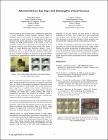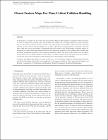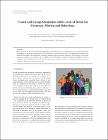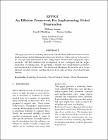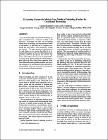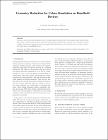Browsing by Author "O'SULLIVAN, CAROL ANN"
Now showing items 8-27 of 54
- Sort by:
- title
- issue date
- submit date
- Order:
- ascending
- descending
- Results:
- 5
- 10
- 20
- 40
- 60
- 80
- 100
-
Attention-driven eye gaze and blinking for virtual humans
PETERS, CHRISTOPHER; O'SULLIVAN, CAROL ANN (ACM Press, 2003) -
Bottom-up visual attention for virtual human animation
PETERS, CHRISTOPHER; O'SULLIVAN, CAROL ANN (IEEE Computer Society, 2003)We present a system for the automatic generation of bottom-up visual attention behaviours in virtual humans. Bottom-up attention refers to the way in which the environment solicits one?s attention without regard ... -
Closest feature maps for time-critical collision handling
GIANG, THANH; O'SULLIVAN, CAROL ANN (2005)In this paper we consider the novel idea of Closest Feature Maps (CFMs) applied to refinable collision response in order to address the potential issues and problems associated with over approximation of contact ... -
Clothing the masses: real-time clothed crowds with variation
O'SULLIVAN, CAROL ANN; DOBBYN, SIMON; MCDONNELL, RACHEL (2006)The animation and rendering of crowds of realistically clothed characters presents a difficult challenge in computer graphics, which is further exacerbated when real-time frame rates are required. To date, due to ... -
Collision handling for virtual environments
DINGLIANA, JOHN; GANOVELLI, FABIO; BRADSHAW, GARETH; O'SULLIVAN, CAROL ANN (2001)An efficient and realistic collision handling mechanism is fundamental to any physically plausible Virtual Environment. In this tutorial, we will first examine the applications of collision handling, and introduce the ... -
Collisions and adaptive levels of detail
DINGLIANA, JOHN; O'SULLIVAN, CAROL ANN (ACM Press, 2001) -
Collisions and perception
O'SULLIVAN, CAROL ANN; DINGLIANA, JOHN (ACM, 2001)Level of Detail (LOD) techniques for real-time rendering and related perceptual issues have received a lot of attention in recent years. Researchers have also begun to look at the issue of perceptually adaptive techniques ... -
Complementarity based multiple point collision resolution
GIANG, THANG; BRADSHAW, GARETH; O'SULLIVAN, CAROL ANN (2003)Collision detection and response is one of the most extensively researched areas in computer graphics but yet, very little information is available on how to deal with multiple collision situations after they have been ... -
Crowd and group simulation with levels of detail for geometry, motion and conversational behaviour
CASSELL, JUSTINE; VILHJALMSSON, HANNES; PETERS, CHRISTOPHER; LEESON, WILLIAM; GIANG, THANH; DINGLIANA, JOHN; DOBBYN, SIMON; O'SULLIVAN, CAROL ANN (2002)Work on levels of detail for human simulation has occurred mainly on a geometrical level, either by reducing the numbers of polygons representing a virtual human, or replacing them with a two-dimensional imposter. ... -
Crowd creation pipeline for games
DOBBYN, SIMON; MCDONNELL, RACHEL; O'SULLIVAN, CAROL ANN (2006)With the increase in realism of games based in stadiums and urban environments, real-time crowds are becoming essential in order to provide a believable environment. However, realism is still largely lacking due to the ... -
Distributed mobile multi-user urban simulation
ROSSI, CLODAGH; O'SULLIVAN, CAROL ANN (ACM Press, 2003)This sketch gives an overview of the completed and ongoing research involved in developing a 3D multi-user environment on low-end mobile devices. -
Efficient collision detection for spherical blend skinning
O'SULLIVAN, CAROL ANN (ACM Press, 2006)Recently, two algorithms improving the real-time simulation of articulated models in virtual environments have been published: 1) fast collision detection for linear blend skinning and 2) spherical blend skinning. Both ... -
EFFIGI: An Efficient Framework for Implementing Global Illumination.
LEESON, WILLIAM; COLLINS, STEVEN; O'SULLIVAN, CAROL ANN (2000)This paper presents a rendering framework called EFFIGI (Efficient Framework For Implementing Global Illumination) that uses interfaces which express both geometric concepts and mathematical ones, using object-oriented and ... -
Evaluating the visual fidelity of physically based animations
DINGLIANA, JOHN; GIANG, THANH; KAISER, MARY K.; O'SULLIVAN, CAROL ANN; O'SULLIVAN, CAROL ANN (2003)For many systems that produce physically based animations, plausibility rather than accuracy is acceptable. We consider the problem of evaluating the visual quality of animations in which physical parameters have been ... -
An experimental approach to predicting saliency for simplified polygonal models
HOWLETT, SARAH; HAMILL, JOHN; O'SULLIVAN, CAROL ANN (ACM Press, 2004)In this paper, we consider the problem of determining feature saliency for 3D objects and describe a series of experiments that examined if salient features exist and can be predicted in advance. We attempt to determine ... -
Extracting geometric models from medieval moundling profiles for case-based reasoning
BRADSHAW, GARETH; O'SULLIVAN, CAROL ANN (2000)Cross-sectional profiles of medieval mouldings are often considered to be a vital form of data for art historians. Mouldings have often been used to highlight salient areas of buildings, and they provide a wealth of ... -
Fidelity metrics for animation
O'SULLIVAN, CAROL ANN (2004)In this paper, the problem of evaluating the fidelity of animations will be addressed. Plausible simulation and the perceptual impact of animations generated using approximations or interactive manipulation will be ... -
A framework for comparing task performance in real and virtual scenes
O'SULLIVAN, CAROL ANN (ACM Press, 2005)In this paper, we describe a framework for comparing task performance in real and virtual environments. Realistic graphics, rear projection, haptics and rapid prototyping are used to match the virtual scene to the real ... -
Geometry reduction for urban simulation on handheld devices
O'SULLIVAN, CAROL ANN (2005)We present a real-time urban simulation on a Personal Digital Assistant (PDA). An existing desktop urban simulation is used to automatically generate potential visibility data, sub-divide the world into areas of similar ... -
Harnessing the human visual system for image based modeling: an interaction system
O'SULLIVAN, CAROL ANN (2006)We present a novel interaction system for modeling 3D geometry from photographs. Given a set of stereo pairs, along with their camera parameters, the interface tracks the movements of the users and allows them to ...




